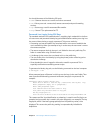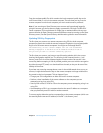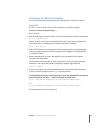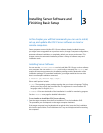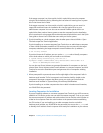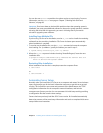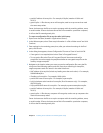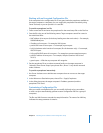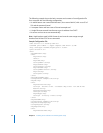
40 Chapter 3 Installing Server Software and Finishing Basic Setup
You can also use diskutil to partition the volume and to set up mirroring. For more
information, see the diskutil man page or Chapter 7, “Working with Disks and
Volumes,” on page 83.
Important: Don’t store data on the hard disk partition where the operating system is
installed. If you must store additional software or data on the system partition, consider
mirroring the drive. With this approach, you won’t risk losing data if you need to
reinstall or upgrade system software.
Installing from Multiple CDs
If you’re using CDs for server installation, use the sa_srchr tool to install the remaining
software from the remaining installation CDs. Server Assistant opens automatically
when installation is complete.
1 To use the next installation disc, use the sa_srchr command to locate the computer
that’s waiting. For <ip address>, specify the address you used in step 2:
$ /System/Library/Serversetup/sa_srchr <ip address>
2 When the sa_srchr response includes the string “#InstallInProgress”, insert the next
installation disc:
$ mycomputer.example.com#PowerMac4,4#<ip address>#<mac address> #Mac OS X
Server 10.4#InstallInProgress#2.0#2080
Restarting After Installation
When installation from the disc is complete, restart the computer. Enter:
$ /sbin/reboot
or
$ /sbin/shutdown -r
Automating Server Setup
Normally when you install Mac OS X Server on a computer and restart, Server Assistant
opens and prompts you for the basic information necessary to get the server up and
running. This includes the user name and password of the administrator, the TCP/IP
configuration information for the computer’s network interfaces, and how the
computer uses directory services. You can automate this initial setup task by providing
a configuration file that contains these settings.
Servers that have previously had Mac OS X Server version 10.4 installed automatically
detect the presence of the saved setup information and use it to complete initial server
setup without user interaction.



